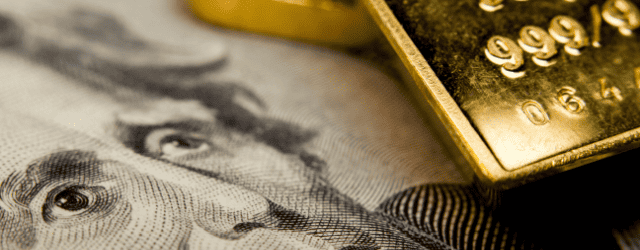Gold Money Explained: The Timeless Value of Precious Metals
May 10, 2023

Gold as Money Explained: A comprehensive analysis of the history and role of gold as a viable currency throughout time. This article delves into the complexities of gold’s role in various monetary systems, from its emergence to current uses.
We’ll start by examining the concept of money and its historical use as a medium of exchange, unit of account, and store of value with gold. As we examine credit versus money systems, you’ll learn about trust in these financial frameworks and how intrinsic value sets gold apart from other forms.
Discover J.P. Morgan’s view on Gold Money Explained along with an evaluation on the decline in dollar purchasing power over time. We then discuss enduring value stored in gold due to scarcity driving demand & price stability and its indestructible nature preserving wealth across generations.
Finally, we provide historical contexts where gold was used as currency such as Ancient Rome & Greece followed by an overview on The Gold Standard system during 19th-20th centuries. Concluding with modern monetary systems involving central banks’ use of gold reserves and options like physical gold vs ETFs.
Table Of Contents:
- The Definition of Money and Gold’s Role
- Credit vs. Money – Trust and Promises
- J.P. Morgan’s View on Gold as Money
- The Decline in Dollar Purchasing Power Over Time
- Enduring Value Stored in Gold
- Historical Contexts Where Gold Was Used As Currency
- Modern Monetary System and Gold’s Role
- FAQs in Relation to Gold Money Explained
- Conclusion
The Definition of Money and Gold’s Role
Understanding the concept of money is crucial to answering the question, “Is gold money?” Explore the standard economic definition of money and how gold fits into this framework. To be considered as money, an asset must fulfill three main functions:
- Medium of exchange in transactions: A widely accepted means for buying goods and services.
- Unit of account for measuring value: A consistent method to express prices and record debts.
- Store of value over time: The ability to maintain purchasing power across generations.
In ancient civilizations like Rome and Greece, gold coins were used as currency, serving all three functions. However, with modern monetary systems shifting towards paper currencies backed by central banks’ policies, it becomes essential to analyze if gold still holds its status as a viable form of currency today.
A key factor that sets gold apart from other forms is its intrinsic value derived from scarcity. Unlike paper currencies which can be printed at will by governments or central banks leading to inflationary pressures on their market price, physical gold remains scarce due to limited global reserves making it less susceptible against fluctuations in trade deficit or world war scenarios. This characteristic allows it not only to act as a medium of exchange but also to store wealth across generations, providing stability within uncertain economic environments, thereby fulfilling all criteria required to be considered a genuine form of ‘money’.
Throughout history, gold has been a significant part of our economic system and continues to influence its evolution. Next, let’s delve into the distinctions between money-dependent and credit-based structures, as well as the significance of assurance in each.
Credit vs. Money – Trust and Promises
Understanding the differences between credit and money is essential to comprehend gold’s role as a viable currency. Credit relies on trust, as it involves a promise to pay in the future, while proper money holds intrinsic value that doesn’t require repayment promises or trust.
The Role of Trust in Credit-Based Systems
In a credit-based system, individuals and institutions extend loans or lines of credit with the expectation that they will be repaid at a later date. Trust is a crucial factor in credit-based systems, as there is always the potential for one party to not fulfill their obligations. For example, fractional reserve banking allows banks to lend out more money than they have in deposits, which can lead to bank runs if depositors lose faith in the institution’s ability to repay them.
Intrinsic Value: A Key Feature Distinguishing Gold from Other Forms
Gold has been considered valuable for thousands of years due to its scarcity, indestructibility, and universal acceptance across cultures. In contrast to fiat currencies, gold’s value is derived from its inherent features rather than being dependent on external influences such as economic policies or trade imbalances. As central banks around the world continue printing more paper money without any tangible backing (e.g., quantitative easing), many customers view physical gold as an attractive alternative asset class capable of preserving wealth against inflationary pressures caused by excessive money supply growth.
Credit-based systems rely on trust and promises, but gold stands out as a form of money that has intrinsic value. J.P Morgan’s views on gold will further illustrate the importance of this precious metal in financial markets.
J.P. Morgan’s View on Gold as Money
In 1912, the renowned American financier James Pierpont Morgan famously declared that “Gold is money; everything else is credit.” This statement highlights his belief in gold’s intrinsic value and enduring worth compared to paper promissory notes, which can be cheaply printed and are subject to inflation.
Morgan’s opinion was shaped by the Panic of 1907, an episode that caused a lot of banks to collapse and brought financial distress. At the time, many people lost faith in paper currency due to its lack of tangible backing. In contrast, gold has always been considered a reliable store of value because it cannot be easily manipulated or debased like fiat currencies.
- Gold vs Paper Currency: While central banks can print more paper money at will, leading to an increase in supply and potential inflationary pressures, gold supplies are limited by nature. This scarcity helps maintain its purchasing power over time.
- Durability & Divisibility: Unlike most forms of currency throughout history (such as livestock or grain), gold coins have proven durable and divisible into smaller units without losing their inherent value – essential qualities for any viable form of money.
- Universal Acceptance: Gold has long been recognized worldwide as a valuable commodity with consistent market prices across different countries – making it ideal for international trade during times when national currencies were less stable or widely accepted.
In light of these factors, it’s clear that gold has played a crucial role in the global monetary system for centuries. While paper currencies have come and gone, gold remains a trusted form of money with enduring value. The gold standard, which tied the value of a country’s currency to a fixed amount of gold reserves, was widely used until the mid-20th century. However, due to the high cost of maintaining gold reserves and the need for more flexible monetary policy, most countries have since abandoned it.
Despite this, gold remains a popular choice for individuals and central banks alike. Its market price is influenced by a variety of factors, including inflation rates, trade deficits, and geopolitical tensions. As a result, gold can serve as a hedge against economic uncertainty and a way to diversify one’s portfolio beyond traditional assets like stocks and bank deposits.
J.P. Morgan believes that gold can be a reliable hedge against inflation and currency devaluation, as well as providing long-term value preservation. Given the depreciation of the U.S dollar, buying gold through a Precious Metals IRA may be an effective way to protect against inflation and ensure long-term financial stability.
The Decline in Dollar Purchasing Power Over Time
With the abandonment of the gold standard, inflation has been a constant threat to fiat currencies like the US dollar, leading to a gradual decrease in purchasing power over time. Since the abandonment of the gold standard, central banks have been able to manipulate monetary policy and increase money supply, leading to a continuous decrease in the value of paper money.
In fact, according to data from the Bureau of Labor Statistics, it’s estimated that within just half a century, from 1971-2023, the dollar has lost nearly 86% of its purchasing power. This means that what you could buy for $100 back then would now cost around $640.
- Impact on savings: The decline in purchasing power directly affects people’s ability to save for retirement or future expenses. As bank deposits yield low interest rates compared to the inflation rate, individuals must seek alternative assets such as gold or stocks.
- Rising trade deficit: A weakening currency can also contribute towards an increasing trade deficit. When domestic currency loses value against foreign currencies, imported goods become more expensive while exports lose competitiveness. This imbalance leads nations into debt and economic instability.
- Economic consequences: Persistent loss in purchasing power may trigger higher interest rates by central banks aiming at controlling inflation levels. However, this measure often results in slowing down economic growth and causing unemployment due to high borrowing costs businesses face during these periods.
Many are turning to gold as a currency and asset in times of economic difficulty, which is understandable. Gold money, gold currency, and gold coins have been used as a means of exchange for centuries and have proven to be a reliable store of value. In fact, many central banks still hold gold reserves as a hedge against inflation and economic instability.
Buying gold can also provide protection against market price fluctuations and currency devaluation. During times of economic crisis, gold tends to hold its value or even increase in price, making it a valuable asset for customers.
Overall, while paper money may be subject to the whims of central banks and inflation, gold remains a stable and reliable alternative for those seeking to protect their wealth and purchasing power.
The depreciation of the dollar has resulted in inflation, making it difficult for people to maintain their buying power. As an alternative store of value, gold has proven itself as a reliable asset due to its scarcity and durability, providing enduring wealth across generations.
Enduring Value Stored in Gold
In the world of money markets, gold has consistently proven to be one of humanity’s greatest stores of value. Its enduring appeal can be attributed to several factors that contribute towards maintaining stable prices for this precious metal.
Scarcity Driving Demand & Price Stability
The scarcity of gold is a key factor behind its sustained value. Unlike paper money or digital currencies, which can be printed or created at will by central banks and governments, gold reserves are finite. This limited supply ensures that gold remains a viable currency, as it cannot be devalued through excessive production like fiat currencies often are during times of economic turmoil or high inflation rates.
Indestructible Nature Preserving Wealth Across Generations
Gold’s indestructibility further adds to its status as an excellent store of value. It does not corrode, tarnish, or decay over time – qualities that make it ideal for preserving wealth across generations. In fact, many ancient artifacts made from gold have survived thousands of years without losing their luster or value (source). This durability stands in stark contrast to paper money and other assets such as stocks and bonds which may lose their worth due to market fluctuations or company failures.
In addition to these inherent characteristics, the universal acceptance of gold also plays a significant role in its ability to retain value throughout history. As a result, customers continue turning towards this timeless asset class when seeking long-term financial security amidst unpredictable markets and uncertain monetary policies.
The value stored in gold is an enduring one, as its scarcity and indestructible nature have preserved it through the ages. This historical context of gold being used as currency further reinforces why many customers choose to purchase precious metals like gold today.
Historical Contexts Where Gold Was Used As Currency
In this section, we will explore various historical periods where gold was used as a form of currency, from ancient civilizations to the modern era. Understanding how societies have relied on this precious metal for trade and wealth preservation can provide valuable insights into its enduring appeal.
Gold Coins in Ancient Rome & Greece
The use of gold coins as currency dates back to ancient civilizations such as Rome and Greece. In these societies, gold was not only a form of currency but also represented authority and prestige. For example, during the reign of Alexander the Great (356-323 BC), his image was minted onto gold coins that circulated throughout his vast empire.
The Gold Standard System in 19th-20th Centuries
In more recent history, many countries adopted the gold standard system, which linked their paper money directly to gold reserves. In the early 18th century, England pioneered the gold standard system which was eventually adopted by many countries worldwide by the late 19th century. Under this system, central banks maintained fixed exchange rates between their currencies and a specific amount of gold. The United States followed suit with the Coinage Act of 1873 until President Richard Nixon abandoned it in favor of fiat currency in 1971 due to mounting economic pressures like inflation rate increases and trade deficit concerns following World War II.
Gold money has been a viable currency for centuries, and its value has remained relatively stable over time. Unlike paper money or bank deposits, gold cannot be created out of thin air by central banks, making it a reliable store of value. Additionally, gold’s market price tends to rise during times of economic uncertainty, making it a popular hedge against inflation and market volatility.
While gold is no longer used as a primary form of currency, it remains an important asset for customers and central banks alike. Understanding its historical significance and role in monetary policy can provide valuable insights into its potential as a long-term investment.
The historical use of gold as currency is a testament to its enduring value and importance, which has been maintained even in modern times. Central banks’ holding of gold reserves and customers being able to acquire physical bullion or ETFs demonstrate the ongoing relevance of this precious metal in today’s economy.
Modern Monetary System and Gold’s Role
Fiat currencies, central banks and fractional reserve banking are the basis of today’s monetary system. While gold no longer serves as a primary form of currency, it still plays a significant role in the global economy.
Central banks’ use of gold reserves
Central banks maintain large stores of gold as part of their currency reserves, safeguarding against market volatility and offering an economic boost to nations with sizeable trade deficits. This precious metal acts as an insurance policy against economic uncertainty or fluctuations in paper money value. Additionally, countries with large trade deficits often accumulate gold to bolster their financial position on the international stage.
Purchasing physical gold vs. ETFs
Customers can also benefit from including gold in their portfolios. One option is to purchase directly in physical bullion, such as coins or bars. This allows for direct ownership and control over one’s assets while providing protection against inflation rate increases and market price volatility.
An alternative method is buying through gold-backed Exchange Traded Funds (ETFs). These funds track the price of gold without requiring customers to store or manage physical assets themselves, offering convenience at lower costs compared to owning tangible bullion outright.
No matter which route you choose, incorporating some exposure to this enduring asset class into your strategy can serve as a hedge against economic uncertainty and help preserve your wealth for future generations.
FAQs in Relation to Gold Money Explained
How Does Gold Represent Money?
Gold represents money due to its intrinsic value, scarcity, and indestructible nature. As a medium of exchange in transactions, unit of account for measuring value, and store of value over time, gold has been used as currency throughout history. Its unique properties make it an enduring form of wealth that can be preserved across generations.
What Was the Biggest Problem with the Gold Standard?
The biggest problem with the gold standard was its inflexibility in times of economic crisis or war. The fixed exchange rate between currencies and gold limited governments’ ability to manage monetary policy effectively during recessions or periods of high inflation. This rigidity ultimately led to financial instability and contributed to the abandonment of the gold standard.
What Is the Gold Standard Explained?
The gold standard refers to a monetary system where a country’s currency is directly linked to a specific amount of gold. Under this system, countries agreed on fixed exchange rates between their currencies and set amounts of physical gold held in reserves by central banks. It aimed at providing stability for international trade but faced challenges like lack of flexibility in managing monetary policies.
Conclusion
In conclusion, gold has played a significant role in the history of money as a medium of exchange, unit of account, and store of value. Its intrinsic value distinguishes it from other forms, and its scarcity drives demand and price stability while preserving wealth across generations.
Today, central banks still hold gold reserves, and customers can choose to purchase physical gold or silver. Understanding the enduring value stored in gold is important for anyone looking to diversify their portfolio or protect their wealth against inflation.
If you’re interested in buying alternative assets like physical gold, visit American Alternative Assets today!












